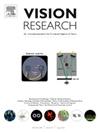Fixational eye movements and edge integration in lightness perception
IF 1.4
4区 心理学
Q4 NEUROSCIENCES
引用次数: 0
Abstract
A neural theory of human lightness computation is described and computer-simulated. The theory proposes that lightness is derived from transient ON and OFF cell responses in the early visual pathways that have different characteristic neural gains and that are generated by fixational eye movements (FEMs) as the eyes transit luminance edges in the image. The ON and OFF responses are combined with corollary discharge signals that encode the eye movement direction to create directionally selective ON and OFF responses. Cortical neurons with large-scale receptive fields independently integrate the outputs of all of the directional ON or OFF responses whose associated eye movement directions point towards their receptive field centers, with a spatial weighting determined by the receptive field profile. Lightness is computed by subtracting the spatially integrated OFF activity from spatially integrated ON activity and normalizing the difference signal so that the maximum response in the spatial lightness map at any given time equals a fixed activation level corresponding to the percept of white. Two different mechanisms for ON and OFF cells responses are considered and simulated, and both are shown to produce an overall lightness model that explains a host of quantitative and qualitative lightness phenomena, including the Staircase Gelb and related illusions, failures of lightness constancy in the simultaneous contrast illusion, Chevreul’s illusion, lightness filling-in, and perceptual fading of stabilized images. The neural plausibility of the two variants of the theory, as well as its implication for lightness constancy and failures of lightness constancy are discussed.
亮度感知中的注视眼动与边缘整合。
描述了一种人体亮度计算的神经理论,并进行了计算机模拟。该理论提出,亮度来源于早期视觉通路中的瞬时ON和OFF细胞反应,这些细胞反应具有不同的特征神经增益,并且在眼睛通过图像中的亮度边缘时由固定眼动(FEMs)产生。打开和关闭反应与相应的放电信号相结合,这些信号编码了眼运动方向,从而产生方向选择性的打开和关闭反应。具有大规模感受野的皮质神经元独立地整合所有定向ON或OFF反应的输出,这些反应的相关眼动方向指向它们的感受野中心,其空间权重由感受野轮廓决定。亮度的计算是通过从空间集成的ON活动中减去空间集成的OFF活动,并将差分信号归一化,使空间亮度图中任何给定时间的最大响应等于与白色感知相对应的固定激活水平。考虑并模拟了ON和OFF细胞反应的两种不同机制,两者都被证明产生了一个整体的亮度模型,该模型解释了许多定量和定性的亮度现象,包括楼梯Gelb和相关的错觉,同时对比错觉中的亮度恒定失败,Chevreul错觉,亮度填充和稳定图像的感知褪色。讨论了该理论的两种变体的神经合理性,以及其对轻恒性和轻恒性失效的含义。
本文章由计算机程序翻译,如有差异,请以英文原文为准。
求助全文
约1分钟内获得全文
求助全文
来源期刊

Vision Research
医学-神经科学
CiteScore
3.70
自引率
16.70%
发文量
111
审稿时长
66 days
期刊介绍:
Vision Research is a journal devoted to the functional aspects of human, vertebrate and invertebrate vision and publishes experimental and observational studies, reviews, and theoretical and computational analyses. Vision Research also publishes clinical studies relevant to normal visual function and basic research relevant to visual dysfunction or its clinical investigation. Functional aspects of vision is interpreted broadly, ranging from molecular and cellular function to perception and behavior. Detailed descriptions are encouraged but enough introductory background should be included for non-specialists. Theoretical and computational papers should give a sense of order to the facts or point to new verifiable observations. Papers dealing with questions in the history of vision science should stress the development of ideas in the field.
 求助内容:
求助内容: 应助结果提醒方式:
应助结果提醒方式:


